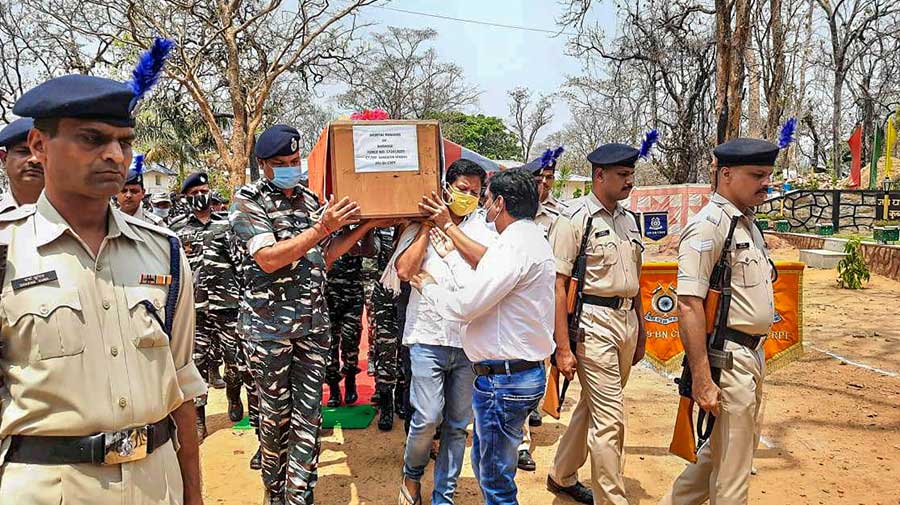Several security experts on Sunday questioned the Narendra Modi government’s anti-Maoist policy as news arrived that the insurgents had ambushed and killed at least 22 security force personnel in Chhattisgarh.
“The recurring attacks on security personnel in Chhattisgarh belie the government’s tall claim that the demonetisation had choked the Maoists’ funds and broken their backbone,” a former CRPF director-general told The Telegraph.
He said Amit Shah had after taking over as Union home minister in 2019 told the security bosses at his first meeting with them that Kashmir and the Maoist insurgency were his topmost priorities.
“But the government has so far not delivered. This government has no strategic formulation to counter the Maoists,” the ex-DG said.
Soon after coming to power in 2014, the Modi government had promised a “hard-nosed” anti-Maoist policy, criticising the UPA for adopting what it alleged was a “weak-kneed” strategy.
Then home minister Rajnath Singh had unveiled a four-pronged strategy after meeting the chief secretaries and police chiefs of the 10 Maoist-affected states, including Chhattisgarh.
The four prongs were: security, development, the rights and entitlements of the tribal people, and the management of the public perception.
However, the ambitious policy remained on paper, apparently because the home ministry failed to achieve the required level of coordination with other ministries such as tribal affairs, rural development, road transport and highways, and environment and forests.
“The policy got tied up in red tape and finally junked. It required inter-ministerial consultations, and the infrastructure-related projects needed clearances from other ministries,” a home ministry official said.
He said that during the UPA rule, then home minister P. Chidambaram too had announced a “clear, hold and develop” policy but it did not yield significant results.
The dead
Eight of the dead jawans were from the District Reserve Guard, seven from the CRPF’s elite Cobra commando unit, six from state police’s special task force and one from the CRPF’s Bastariya battalion. The lone missing jawan belongs to the Cobra unit.
Two of the dead Cobra commandos were from Assam: Dilip Kumar Das from Barpeta and Bablu Rambha from Goalpara.
Shah meeting
Shah cut short his election campaign in Assam, returned to Delhi and held a high-level meeting on Sunday evening to review the security situation in Chhattisgarh. Home secretary Ajay Bhalla, Intelligence Bureau director Arvind Kumar and senior CRPF officials attended the meeting.
Shah had earlier told reporters in Assam the government would give a fitting reply.
President Ramnath Kovind and Congress leader Rahul Gandhi tweeted condolence messages.
Chhattisgrah chief minister Bhupesh Baghel promised intensified anti-Maoist operations.
Bloodshed theatre
Maoists have killed security personnel in a series of attacks in Chhattisgarh since the demonetisation.
On March 23 this year, five District Reserve Guard personnel were killed when the Maoists blew up their bus in Narayanpur district.
On March 21 last year, 17 jawans were killed in an ambush in Minpa, Sukma.
On April 9, 2019, BJP legislator Bhima Mandavi and four security personnel were killed when the Maoists blew up their vehicle in Dantewada.
In April 2017, the Maoists massacred 25 CRPF personnel in Burkapal, Sukma, a month after killing 12 CRPF jawans in Sukma.
Of the country’s 31 Maoist-hit districts, 13 are in Jharkhand, 8 in Chhattisgarh and 4 in Bihar. Intelligence reports suggest the rebels are regrouping in Chhattisgarh, Bihar, Jharkhand and Maharashtra.
A Union home ministry report says that Chhattisgarh and Jharkhand together accounted for over 70 per cent of Maoist violence and 75 per cent of the killings in 2017 and 2018. Bihar, Odisha and Maharashtra reported 13 per cent, 8.2 per cent and 7.1 per cent of the violence, respectively.
Some 90,000 CRPF personnel are now deployed in the Maoist zones of Chhattisgarh, Jharkhand and Andhra Pradesh.











